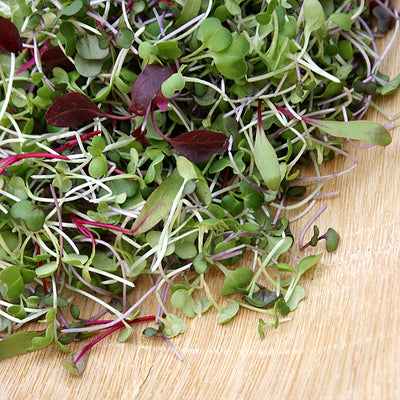
The Gastronomic Gardener: 4 Varieties To Grow Korean Cuisine
Written by - Kaitlynn from MIgardener
As an avid gastronome, the fact that there are over 15,000 different varieties of tomatoes in the world is thrilling to me. I know that 15,000 tomato varieties mean 15,000 different flavor options. Differences in color, acidity, sweetness, and texture. Imagine you are a chef. Now imagine that you are a chef who has the entire world of flavor at your fingertips? Endless possibilities. Did you know there were so many varieties? That's why I'm here. In this new blog series, we will take a journey through the world's most fantastic food varieties. Hopefully, someday, you will become a gastronome just like me.
Today, we will explore the wonderful world of Korean cuisine. In Michelle Zauner's touching article in The New Yorker, she describes her experience of bonding with her Korean mother in the kitchen. The emotional, cultural connections she has to the food she grew up eating translated into every recipe. Inspired by her, this post will show you some of the most exciting varieties used in Korean cuisine. These varieties can be grown at home, making delicious ingredients accessible to you.
Beginner's tip: When you are introduced to outside of your comfort zone foods, it's helpful to remember that different does not mean wrong. This mindset allows you to expand your pallet and your experience.
Soybean Sprouts (Kongnamul)
The first cornerstone variety is simple: soybeans. Korean recipes require soy at impressively high rates in a diverse number of ways. However, soybean sprouts are the most used form of soy. Homegrown kongnamul (soybean sprouts) have beautiful, long roots compared to what is available in stores. They also have a higher mineral content and a stronger, nuttier flavor. The kongnamul variety is explicitly used for sprouting because it is slightly smaller than standard edamame beans. To learn how to sprout soybeans the right way, check out Maagchi on Youtube. This variety only requires sprouting indoors unless you're looking to grow your own soy plant. These sprouts are so easy to grow that they are the perfect gateway to Korean flavors.
Recipes: red or white kongnamul-muchim (seasoned kongnamul side dish), Banjirak-kongnamul-gut (clam and kongnamul soup), Kongnamul-gukbap (hangover soup with rice), and many more.
Korean Radishes (Mu)
Sometimes a classic red and white radish just doesn't cut it. Sure they might taste similar enough, but for the amount of radish that goes into soups, kimchi, and side dishes, you're going to need the biggest radish you can find. Also known as the Alpine radish, Jeonmu is the most common variety of radishes grown in Korea. Uniquely white with green shoulders. A stockier version of the Japanese daikon. Jeonmu is slightly sweeter than Japanese varieties and will absorb any flavor your surround it with.
Recipes: Donchimi (radish water kimchi), Kkakdugi (radish kimchi), Danmuji (pickled radish), Tongbaechu Kimchi (Traditional Kimchi), and more.
Perilla Leaves (kkaennip)
Korean perilla leaves are an easy to grow option for any gardening beginner. Though perilla is a member of the mint family, it's growing habit is more like basil. Perilla leaves are large and grow as big as 6 inches apiece. It's bushlike growing habit flowers to attract butterflies and pollinators to the garden. The leaves have a strong minty flavor and are eaten like any vegetable, while the seed is used as a source for delicious cooking oil. Both are used often in Korean recipes. However, be careful where you plant this variety because it is toxic to animals and livestock.
Recipes: Kkaennip-kimchi (perilla leaf kimchi), Kkaennip jangajji (perilla leaf pickle), Kkaennip-jeon (Pan-fried perilla leaves), and more
Napa Cabbage (baechu)
The main event. Without this variety, it's hard to imagine Korean food would be the same. Napa cabbage is the backbone ingredient to every batch of kimchi. Kimchi is a spicy, tangy, fermented dish that transcends all description. It is eaten as a side, used as a base for soups, and to flavor any dish. Use napa cabbage in soups and wraps, but the most crucial role it plays is in traditional kimchi. Originating in 15th century China, once this variety made its way to Japan and Korea, it quickly became the most iconic dish in Korean cuisine. It is high in vitamin c and calcium. Napa cabbage is a cold-hardy variety that grows best in the spring and fall.
Sadly, this post is not allowed to go on forever. I'll have to skip over a few of the key ingredients and flavors associated with Korean cuisine. Anybody knows that if you're going to learn how to make Korean food, you're going to need to stock up on Korean chili peppers and even more garlic. Get as much garlic as you can get your hands on. You're going to need it.
Conclusion:
That's the surface cracked. Hopefully, this post has either sparked nostalgia or first interest for you! Do you have any experience growing Korean style vegetables? What is your favorite Korean dish to make or eat? Let us know in the comments on facebook.
Check us out at MIgardener.com or on youtube, Instagram, and facebook.
Main Sources: linked throughout the post





Wow look what I found. Please ask Luke to stock soybeans and perilla seeds and mu. Seeds. Ty so much for this blog
Yupersue Akers
Leave a comment